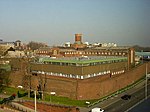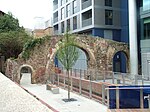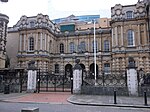Holy Brook

The Holy Brook is a channel of the River Kennet that flows through the English town of Reading. While of considerable historical significance, the origin and nature of the brook is still unclear. It is probable that some parts of the channel are natural, while other parts were created in medieval times by the monks of Reading Abbey to supply water mills and fish ponds. John Speed's map of Reading (c.1610) shows the brook flowing in the open air throughout, but a map from 1835 shows the town centre section to have been largely culverted by then, as is the case now.The Holy Brook leaves the main channel of the Kennet at a brick structure known as the Arrowhead near the village of Theale, and flows to the north of the main channel until rejoining it just downstream of the centre of Reading. The channel is some 6 miles (9.7 km) in length, of which approximately 600 metres (2,000 ft) are culverted.
Excerpt from the Wikipedia article Holy Brook (License: CC BY-SA 3.0, Authors, Images).Holy Brook
Oscar Wilde Memorial Walk, Reading Coley
Geographical coordinates (GPS) Address Nearby Places Show on map
Geographical coordinates (GPS)
| Latitude | Longitude |
|---|---|
| N 51.4556 ° | E -0.9653 ° |
Address
Chestnut Walk
Oscar Wilde Memorial Walk
RG1 3AH Reading, Coley
England, United Kingdom
Open on Google Maps










